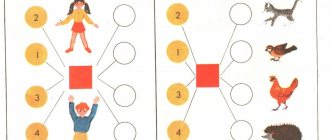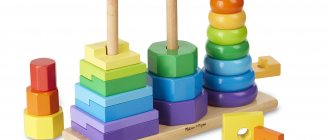Formation of gender, family, civil
Accessories
New approaches to the organization of the educational process, determined by federal state requirements, offer a slightly different approach to the content of moral education of preschoolers, including the formation of a child’s gender identity. It is very important to form a child’s understanding that he is a girl or a boy, and when he grows up, he will be a woman or a man, and this gender will not change depending on the situation or the child’s personal desires. Therefore, among the methodological techniques, observations are offered, looking at photographs of the child’s growth dynamics, conversations about who is who and what he is like.
| Directions | Content | Methodical techniques |
| September | ||
| Gender affiliation | Kindergarten for children: names and patronymics of teachers and nannies, orientation in the group premises, getting to know the children in the group | Inspection of the group. Targeted walk around the site. Conversations: “What is our group like,” “How do we play with toys.” Reading: 3. Alexandrova “Katya in the nursery”, E. Yankovskaya “I go to kindergarten”, “What kind of children are in our group”. Role-playing game "Kindergarten". Productive activity: “Let’s build a kindergarten” |
| Family affiliation | ||
| Citizenship | City holiday, festive decoration of streets and houses, festive fireworks | Targeted walk down the street. Looking at illustrations. Teacher's story. Reading: O. Vysotskaya “Look, the whole city is decorated...” |
| October | ||
| Gender affiliation | Consolidating knowledge of children's names in the group | Didactic game "Who is who" |
| Family affiliation | Orientation in some areas of the kindergarten: music, physical education rooms, comparison with the home environment | Tour of the kindergarten. Teacher's story. Looking at illustrations. Conversation "Who works where." Story-based role-playing games: “Kindergarten”, “Polyclinic”, “Family” |
| Citizenship | The street on which the kindergarten, buildings, institutions are located | Targeted walk down the street. Looking at illustrations and photographs. Conversation “My Street”. Reading: A. Barto “Song about Moscow” |
| November | ||
| Gender affiliation | We are different - girls and boys, cheerful and sad; fixing the names of the children in the group, being friendly towards each other | Determining the differences in the appearance of girls and boys: clothes, hairstyle. Conversations: “We are different”, “Who are you?”, When it’s sad and fun.” Reading: S. Marshak “About Girls and Boys.” Role-playing game "Kindergarten" |
| Family affiliation | My family: family members, their activities, caring for each other | Examination of paintings, illustrations, photographs. Conversations: “Who do you live with”, “How do you help your mother.” Reading: nursery rhymes: “Ladushki-Ladushki”, Russian folk tale “Three Bears”, E. Blaginina “Alyonushka”, K. Ushinsky “Cockerel with his family”. Role-playing games: “Family”, “Birthday of the Bear”. Productive activity: “Handkerchief for mom,” “Pancakes for grandma.” |
| Citizenship | Festive fireworks, beautifully decorated city streets | A targeted walk along a festive street. Looking at illustrations. Conversation “What we saw on the festive street.” Reading: O. Vysotskaya “Flag”, “Look, the whole city is decorated...”, M. Evenson “Flag”. Productive activity: "Salute" |
| December | ||
| Gender affiliation | Girls and boys are friends | Looking at yourself in the mirror. Conversation “How friendly the guys in our group are” |
| Family affiliation | My family: family members, their activities, caring for each other | Looking at paintings and illustrations. Conversations: “Who do you live with”, “How do you help your mother.” Reading: nursery rhymes: “Ladushki-Ladushki”, Russian folk tale “Three Bears”, D. Gabe “My Family”, K. Ushinsky “Cockerel with his Family”. Role-playing games: “Family”, “Birthday of the Bear”. Productive activity: “Handkerchief for mom”, “Pancakes for grandma” |
| Citizenship | Our city of Moscow: where we’ve been, what interesting places we’ve seen. Decorating the city for the holiday. New Year, festive decoration, cheerful mood, gifts from Santa Claus | Looking at illustrations and photographs of familiar buildings in the neighborhood. Conversations: “Our street”, “We live in Moscow”. Reading: A. Barto “Song about Moscow.” Role-playing game “We are driving down the street.” Productive activity: “Let’s build houses on our street.” -Destination walk to decorated buildings. Looking at illustrations and photographs. Conversation “Holiday is coming.” Preparing for the New Year's party - learning poems and songs. Productive activity: “Christmas tree, green needle” |
| January | ||
| Gender affiliation | Reading about girls and boys | Reading nursery rhymes, conversation on the content: “Sleep, Vanyusha”, “Sleep, little dove, little son”, “Ah, Vanyusha, dance!”, “Andrey the Sparrow”; “Masha invited me to visit”, “Our daughter is in the house”, “Our little Masha”, “Katya, little Katya”, etc. |
| Family affiliation | Mom, dad, me - a friendly family | Conversations: “How we celebrated the New Year holiday”, “Little Helpers”. Reading: E. Uspensky “If I were a girl...” |
| Citizenship | The beauty of Moscow in New Year's decorations. The street closest to the kindergarten - large houses, shops and other buildings and institutions | Targeted walks along the street. Conversation “What did you see in Moscow during the New Year holidays.” A targeted walk to a nearby street, observing transport and buildings. Looking at photographs. Conversation “What we saw on the street.” Productive activity: “Different houses”, “Let’s build a tower house” |
| February | ||
| Gender affiliation | Boys' Day. Behavioral culture of girls and boys | Conversation “Congratulations to our boys.” Didactic game "Well-mannered girls and boys." Role-playing game "Kindergarten" |
| Family affiliation | My sisters and brothers | Looking at illustrations and photographs. Conversations: “I have a brother (sister)”, “How I play with my brother (sister)” |
| Citizenship | Holiday of the Russian Army, bright street decorations, fireworks | Conversation “Feast of Fathers and Grandfathers.” Productive activity: “Ships”; "House with Flags" |
| March | ||
| Gender affiliation | Mothers and girls holiday | Teacher’s story “Our girls also have a holiday” |
| Family affiliation | Mother's Day, decorated houses, many flowers, mothers and grandmothers are given gifts | Looking at photographs and illustrations. Conversation “How we congratulate mother.” Matinee. Reading: G. Vieru “Mother’s Day.” Role-playing game "Family" |
| Citizenship |
| April | ||
| Gender affiliation | Girls and boys clothes | Looking at items of clothing. Didactic games: “Let’s dress up a doll (hare)”, “Let’s dress up a bear (Parsley)”. |
| Family affiliation | My grandmother and grandfather | Looking at photographs. Teacher's story. Reading: S. Kaputikyan “My Grandmother”, L. Kvitko “Grandma’s Hands”. Productive activity: “Mittens for grandma”, “Scarf for grandpa” |
| Citizenship | The beauty of Moscow in early spring: landscaping and street cleaning | A targeted walk along the street, observing the implementation of cleanup days, participating as much as possible. Role-playing game “We help at the cleanup day” |
| May | ||
| Gender affiliation | Reinforcing the rules of behavior in kindergarten: in the group, physical education and music halls, halls and corridors, on the site | Observing the games of older children. Conversation “How to behave in kindergarten” |
| Family affiliation | My apartment: consolidate knowledge of the address, safe behavior | Conversations: “The house I live in”, “My toys”, “My favorite pet”, “Do’s and don’ts” (behavior at home). Role-playing game "Family". Productive activity: “My toys”, “My cat Timoshka” |
| Citizenship | We live in Moscow: consolidating knowledge about the name of the city, the nearby street, and the buildings that are located on it. Spring Festival: decorated streets, fireworks | Targeted walk down the street. Looking at illustrations. Conversations: “What we saw on our street”, “We live in Moscow” |
| June August | ||
| Gender affiliation | How girls and boys grew up | Looking at photographs of children in dynamics. Teacher's story “That's how big we are” |
| Family affiliation | My family - consolidation of knowledge about oneself, family members and their activities | Looking at illustrations from the “Family” series. Conversations: “We are a friendly family”, “How I help at home.” Role-playing game "Family". -Productive activity: “Portrait of mom, dad”, “We are walking with mom” |
| Citizenship | We live in Moscow: consolidation of knowledge. Our country is big and beautiful. Children's Day - caring for children | Examination of illustrations, photographs about Moscow, Russia. Conversations: “Where we went with mom and dad,” “Where I like to walk,” “How we vacationed in the summer.” Productive activity: “We were vacationing in the village,” “Our dacha.” A teacher's story, a holiday dedicated to Children's Day |
Cognition
Gender education in kindergarten conditions
Shlyakhova Yulia Romanovna teacher of MBDOU d/s No. 6 of Belgorod
The material is published as part of the work of the creative group “Gender Education of Preschool Children in Kindergarten Settings”
A child is born with a certain biological sex, and takes on a gender role in the process of socialization, i.e. in the process of communicating with other people. Psychologists have proven that by the age of 2, a child begins to understand whether he is a girl or a boy, and from 4 to 7 years old, children already realize that girls become women, and boys become men, that gender is preserved regardless of the situations that arise or the desires of the child. (that is, gender stability is formed).
Physiologists, psychologists and teachers believe that the formation of gender stability is determined by sociocultural norms and depends primarily on the attitude of parents to the child, the nature of parental attitudes and the attachment of both mother to child and child to mother, as well as on his upbringing in a preschool educational institution .
Once upon a time in Russia, gender-role education of children was carried out easily and naturally. Girls spent most of their time with their mother or nanny, and boys were raised by their father or tutor from the age of 3. Children constantly saw their parents, communicated with them, and as a result they formed behavioral stereotypes characteristic of men and women.
The experience of folk pedagogy also shows that even in infancy, children were raised taking into account their gender characteristics. So, for example, in lullabies, pestushki, nursery rhymes, games, there is an appeal not just to a small child, but to girls and boys. Depending on who exactly the nursery rhyme or pester is addressed to, a girl or a boy, their future is predicted. The work of girls in the future is associated with harvesting, cooking, sewing clothes, and boys - with hunting and fishing, cutting wood, caring for domestic animals, etc.
In modern society, there is such an option for upbringing: both girls and boys are most often raised by women: at home - by mother or grandmother, and in kindergarten - by female teachers.
Advertising message
Social changes taking place in modern society have led to the destruction of traditional stereotypes of male and female behavior. The democratization of gender relations led to a confusion of gender roles, the feminization of men and the masculinization of women. Nowadays it is no longer considered out of the ordinary for representatives of the fair sex to smoke and use foul language; many of them have begun to occupy leading positions among men, and the boundaries between “female” and “male” professions are blurring. Some men, in turn, lose the ability to play the right role in marriage; from “breadwinners” they gradually turn into “consumers,” and they shift all the responsibilities for raising children onto women’s shoulders, which we sometimes notice in the families of our students.
If in the preschool years it is not inculcated in girls - softness, tenderness, neatness, the desire for beauty, and in boys - courage, firmness, endurance, determination, a chivalrous attitude towards representatives of the opposite sex, i.e., one does not develop the prerequisites for femininity and masculinity, then this can cause them to perform poorly in their family, community and social roles as adult men and women.
Most parents want to see their sons in the future: responsible, courageous, decisive, resilient, strong. They want to see their daughters: affectionate, beautiful, graceful.
Addressing the gender aspect in education is justified by the existence of a number of problems:
- Decreased health levels for boys and girls.
- Dulling or loss of sense of gender identity.
- Increasing inappropriate behavior patterns among young people.
Observing the pupils of our kindergarten, we noted that many girls lack modesty, tenderness, patience, and do not know how to peacefully resolve conflict situations. Boys, on the contrary, do not know how to stand up for themselves, are physically weak, lack stamina and emotional stability, and they lack a culture of behavior towards girls. The content of children’s games is also alarming: children demonstrate patterns of behavior that do not correspond to the child’s gender, do not know how to negotiate in the game, or assign roles. During work, children do not know how to independently distribute responsibilities taking into account the gender of their partner.
A boy and a girl cannot be raised and trained in the same way. They perceive the world differently, look and see differently, listen and hear differently, speak and remain silent, feel and experience differently.
Psychological differences between boys and girls
- Girls are more obedient than boys
- Boys want to excel more
- Boys are more creative than girls
- Girls are more productive than boys
- Boys take up more space
- Boys shouldn't cry
- Boys perceive most information visually, while girls perceive most information auditorily.
How do boys differ from girls:
- When dressing, boys will put on their top first, then their bottom;
- Girls, usually on the contrary, will put on the bottom first, then the top;
- The boys take off their T-shirt by grabbing it on the back with their hand and pulling it over their head;
- Girls, undressing, take off their blouse with both hands, pulling it up;
- Yawning, the boys cover their mouths with their fists; Girls - with your palm;
- When boys turn around when called, they turn their bodies because their necks are not so flexible;
- The girls only turn their heads;
- In boys, breathing involves the abdominal muscles;
- Girls breathe with their chests;
- Lost in thought, the boys scratch their chins and necks;
- Lost in thought, the girls wrap a strand of hair around their finger;
- Adjusting their hair, the boys run their hands through their hair, smoothing it;
- When straightening their hair, girls fluff their hair, fluffing it with their fingers;
- When climbing (descending) a mountain, boys simply spread their legs wider.
- Girls try to climb (descend) sideways;
- Examining their heels, the boys lift their foot and look at it from the front;
- Examining their heels, the girls turn behind them;
- Boys - the belt on the robe is tied below the navel;
- Girls - The belt on the robe is tied above the navel, at the waist;
- M - Ears are covered with palms;
- D - Ears are plugged with fingers;
- Trying to get comfortable in a chair, the boys spread their legs wide apart, or place the foot of one leg on the knee of the other;
- Trying to get comfortable in the chair, the girls tuck their legs under them;
- When telling a secret, boys simply lower their voices and bow their heads;
- Girls cover their mouth and their friend’s ear with their palm;
- When brushing their teeth, the boys spread their legs wide and rest their free hand on the edge of the sink.
- While brushing their teeth, girls rest their hand on their side
This means that the problem of raising and educating a child in accordance with his gender is an urgent task of pedagogical work with preschool children.
The goals, methods and approaches of raising boys and girls should be different. Biological sex differences bring with them different emotional, cognitive, and personality characteristics. Hence the need for a differentiated approach in raising boys and girls from the first days of life arises.
In the Veraksa program “From birth to school”, starting from the 1st junior group, the educational area “Socialization” includes the following task:
- the formation of gender, family, citizenship, patriotic feelings, a sense of belonging to the world community.
In order for the upbringing of children in a preschool educational institution to be carried out taking into account their gender characteristics, teachers and specialists must develop gender competence, which involves teachers mastering the organizational, psychological, pedagogical and didactic aspects of managing children's activities with an emphasis on gender identity.
This year, 2022, the World of Preschool Children portal is planning a seminar on gender education in preschool educational institutions and the family. view information HERE
Gender aspect in teaching children of senior preschool age
This article examines the conditions for the formation of gender self-identification and gender stereotypes among kindergarten students of senior groups. The importance of these aspects of education for successful socialization upon entry into adulthood is emphasized. The forms and methods of gender education, tested in practice, are described.
Key words: preschool age, gender education, gender stereotypes, gender identity, gender self-identification, gender identity
The formation of personality largely depends on how successfully gender education takes place, including the creation of ideas about the content of gender-typical behavior and the desire to repeat them in one’s behavior, as well as preferences and interests specific to one or the other gender. This is self-confidence, certainty of personal attitudes and, ultimately, the effectiveness of communication with children of the opposite sex. It is important to lay the foundations of femininity and masculinity in the early years. This determines the content of the work to implement a differentiated approach in the upbringing and education of boys and girls.
Boys and girls are so different that they require significant differences in upbringing. From the moment of birth, boys and girls perceive the world differently.
Communication between boys and girls appears as a special model of social behavior, which reflects a system of ideas about one’s image, manifested in different situations, in activities, in forms of relationships between boys and girls, determined by gender standards.
The analysis shows that in the general education system, despite progress in the application of a gender approach to education, in a number of aspects general education still remains “male”, i.e., focused on the specific development of male students, on achieving a higher social status.
This results in a discrepancy between girls' educational achievements and their career achievements in adulthood. Gender asymmetry in education affects the plans of modern girls - they reduce the level of their social and professional aspirations. It is noted that the predominance of women among teachers (women make up 85.7% of their total number) in quite a number of cases prevents girls from developing an orientation towards the important social role of women, towards a career, and directs them towards patriarchal values - fulfilling the roles of a wife, mother of the family , housewives. This happens because the personality of a woman teacher is also a result of gender socialization, and most of them are not aware of society’s biased attitude towards the fate of girls and the social functions of women.
Gender is a feature of a person’s biological structure. Gender is a sociocultural “superstructure” over anatomy and physiology. Gender differences are created through the socialization system that fosters unequal skills and personality traits in girls and boys, gender-oriented division of labor, cultural norms accepted in society, status and positional roles, and gender stereotypes.
Gender stereotypes are one of the types of social stereotypes, stable concepts for a given society in a given cultural and historical period about the normative behavior of men and women, a set of common ideas about how men and women should look and behave.
Gender stereotypes arise throughout a child’s life from the moment of birth. The shape and color of clothing, toys and games that are offered to children differ depending on gender and form different character traits in girls and boys. All this is accompanied by comments: “Don’t cry, you’re a boy!”, which imposes a ban on boys showing emotionality; “Be obedient and quiet, you’re a girl!”, which creates obedience in girls. The fact that gender stereotypes vary across cultures is often not well understood. The mentioned stereotypes, being stable, continue to persist even when the actual behavior of men and women changes historically.
Gender identity is a deep sense of belonging to one or another biological sex and sociocultural gender, the self-awareness of a representative of this sex in a social environment.
Gender identity, unlike biological sex, is not inherited biogenetically. It is formed in the child in interaction with family and the wider environment. The emergence of gender identity occurs in 3 stages:
1) the child receives information that there are two genders,
2) the child considers himself to be one of them;
3) on the basis of self-determination, the child organizes his behavior, choosing and preferring certain forms.
Determination of gender begins in the second year of life and is firmly established in the third. By the age of three, a child clearly distinguishes and assimilates his gender specificity and, in addition, quite clearly identifies the gender of those around him.
By the end of the preschool period, the formation of gender identity is usually completed, but it is often based on external signs: boys do not wear dresses and have short hair; girls wear dresses and have long hair. A three-year-old does not rule out the possibility of changing gender by changing her haircut or clothing.
A preschooler may not understand what the main differences are between boys and girls, men and women. More significant gender characteristics (such as emotional attachment, gender-marked character traits, interests, activities, physiological properties) are unknown to the majority (70 percent) of children of this age.
In the science of our era, the constitutional and sociocultural aspects of masculine and feminine principles are distinguished. Gender is constantly influenced by cultural norms that dictate what men should do and what women should do, and by informational messages about how different women and men are.
A child’s gender is a significant factor in his development and social behavior.
Every subject evolves as a representative of one sex or another. Having been born a boy or a girl, a child, in the course of socialization, internalizes a system of rules, norms, and patterns of behavior that bring him closer to the masculine or feminine patterns codified in a given society, and determines the development of the corresponding personal properties. In this way, the child acquires belonging to his gender.
The most important stage for gender socialization is preschool age, since at this stage the most significant personality qualities arise and develop. According to neurophysiology and neuropsychology, differences in the structure and functioning of the brain determine the specific psychological development of children of different sexes. The brains of boys and girls evolve at different rates, at different times, and in different sequences.
Those areas of the left hemisphere that are responsible for speech and logical thinking develop earlier in girls than in boys. Because of this, the figurative-sensual area prevails in them until they reach the age of adolescence.
The scientific literature notes the following areas of differences between girls and boys: in cognitive strategies and ways of forming cognitive functions, speed and methods of processing and assimilating incoming information; in attention management; in forms of activation of emotions; in the motives of activity; in the criteria used for assessing what has been achieved; in behavioral patterns.
Let us present data from our practical activities on gender education of children belonging to the age group of older preschoolers. The material presented in the article can be used by kindergarten teachers in gender education of children of the specified age period.
The formation of children's gender culture begins with their lockers: different pictures are placed on the closets of boys and girls. We pay great attention to the selection of play materials and accessories for play activities for boys and girls. The interior in which preschoolers spend time, from walls, furniture to toys, becomes for them a kind of window into the world.
With the girls, we discuss the interior features in the play corner and decide where they intend to store linen, clothes, dishes, “food products” and other substitute items.
For preschoolers, games such as “Dominoes for Girls”, “Handicraft Girl”, “Fashion Designer-Stylist” are used; girls play with them with great pleasure.
Working with the boy contingent, we discuss a toy “vehicle fleet” and a set of toy tools for young “auto mechanics”. Many families have cars, so boys willingly manipulate a toy police baton.
For children's play activities, we update and expand the role-playing games “Hospital”, “Atelier”, “Hairdresser”, “Shop”.
Adults often do not approve of boys' noisy games. However, we take into account that boys need ample play space, that while playing they develop physically, train in regulating their strength, and expend physical energy. For this reason, we do not prevent these games, but only direct them in the right direction. We purchased darts, boxing gloves, game sets with rules designed to develop dexterity and accuracy (games such as “Dominoes for Boys”, “Loto for Boys”, “Young Fisherman”). Gaining practical experience of gender-oriented behavior in the household sphere is helped by work tasks, also distributed according to gender - boys carry out tasks associated with the use of physical strength, and girls - with diligence and accuracy.
We pay especially close attention to children's literature. Many books for children feature images of grandfather, grandmother, father, mother, son, daughter. Young heroines of fairy tales are characterized by intelligence, perseverance, and resourcefulness, and young heroes of folk tales are, as a rule, zealous and diligent assistants to adults in the household and in everyday life.
You can comprehend the essence of the feminine and masculine principles if you carefully analyze “female” and “male” fairy tales. Thus, for girls, the fairy tales “Morozko”, “Cinderella”, “Swans”, etc. are important, in which the heroine is given certain tasks - to sort out the cereal, bake bread, sew a dress, clean up the hut, etc. - requiring her to dexterity, skills, intelligence, but not the use of physical force.
Informing children is focused on providing preschoolers with knowledge about the opposite sex, about male and female professions, about everyday and ethical culture, about the traditions of folk education.
We take into account that girls are generally more receptive to auditory stimuli, whereas boys are not as good at listening; for them, the use of visual aids is preferable. Therefore, during training, we not only verbally influence children, but also actively use visual demonstration, and also use the tactile channel of perception, allowing children to touch and hold objects in their hands, and combine information with movement.
Drawing classes contribute to the evolution of a child’s gender self-identification and control his emotional and semantic behavior.
The focus on conforming to one’s gender influences the themes of children’s drawings: boys depict highways with racing cars, airplanes and helicopters flying in the sky, ships sailing on the sea, the construction of buildings, and military operations. As for girls, they depict elegantly dressed princesses, bouquets of flowers, blooming gardens, various patterns, mothers with strollers.
Concluding the description, we note that, based on the stated principles, we have drawn up a long-term work plan for gender education of older preschoolers, which formulates the tasks and methods of working with preschoolers; Forms of work include conversations, role-playing games, reading aloud children's literature, didactic games, and children's visual arts.
Forming gender self-identification in children and instilling correct gender stereotypes contributes to their successful socialization when entering adulthood.
Literature:
- Klimina L.V. Gender approach to the education of preschool children // Preschool pedagogy. No. 3. 2012. pp. 24–32.
- Kurbatova S.I. Experience of gender education of children through exposure to fiction // Preschool pedagogy. No. 2. 2012. pp. 39–45.
- From birth to school: a sample preschool education program. M.: Mozaika-Sintez, 2015. 48 p.
- Radziwillova M. A. Gender approach to the education of preschool children in preschool educational institutions // Fundamental Research. No. 4 (2). 2013. pp. 453–456.
- Sokolova S. E. Gender differences in the speech of preschool children // Preschool pedagogy. No. 2. 2013. pp. 14–20.
- Federal State Educational Standard for Preschool Education dated October 17, 2013. No. 1155.








